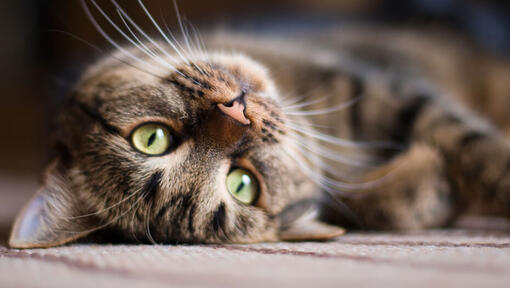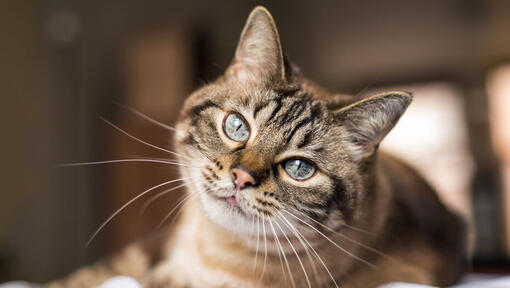Perchè i gatti hanno i baffi?

Whiskers not only make your kitty cute, they also serve many important purposes! From functioning as a built-in measuring tape to aiding near vision, cat whiskers are truly extraordinary!
Cat whiskers are an iconic part of their anatomy. Not only are they incredibly cute and tickle us through the night, they also serve an important purpose. Their whiskers are not hair-like at all (although they may look like it) and they are actually very sensitive .
Maybe you’re wondering why cats have whiskers and want to learn more about your furry friend’s built-in radar system. Read on to find out all about whiskers, from how they work to how they help cats navigate in the dark!
Why do cats have whiskers?
Cat whiskers are truly multifunctional, but their most important function is as a sensory tool. Their official name is vibrissae, which comes from the Latin “vibrio” and means “to vibrate”. The hair follicle in the cat’s whiskers is packed with nerves, and the tip of the whiskers has a sensory organ known as the proprioceptor. All of these characteristics make them incredibly sensitive to vibrations and changes in their surroundings, so cats use them as an additional sense to understand the world.
Furthermore, whiskers are much more ingrained in the body than normal hair, as they are connected to the muscular and nervous systems. This allows whiskers to send sensory messages about their surroundings to the brain, which makes them such adept explorers!
We think cat whiskers are, well, cat whiskers. That’s why we’ve put together our top 10 facts to tell you everything you need to know about your smart cat’s muzzle hair:
1. Cat whiskers aren’t just on the muzzle
If you think that a cat’s whiskers are limited to the nose, they are actually found over the eyes, ears, jaw and front legs as well! The whiskers on the front legs (carpal whiskers) are one of the reasons they are game hunters. success, as they help determine the movement of the prey.
2. The distribution of the whiskers is symmetrical
Cats have an even number of whiskers on their faces, 24 in total. Each side has 12 whiskers in a completely symmetrical distribution, so you can accurately measure the environment.
3. Built-in measuring tape
You may have seen your cat insert its head into an opening before the rest of its body. That’s because the mustache works like a built-in ruler! Because the whiskers are positioned around the width of the cat’s body, they’re excellent for helping him gauge how tight a space is.
4. They work as vibration sensors
Cat whiskers are capable of sensing vibrations in the air, making them incredibly useful when measuring distances or stalking prey. In addition, they are able to detect changes in air currents, allowing them to perceive approaching dangers – a kind of personal radar.
5. They help you see up close
It may surprise you to learn that your cat’s near vision isn’t very good and that they can’t see anything closer than 30cm in front of them. They use their whiskers to orient themselves in the world before them, because by touching them against an object they can figure out where it is, its size and even its texture.
6. Whiskers are an aid to night vision
If you’ve ever wondered how your cat manages to move smoothly through the night without bumping into anything, it’s partly thanks to his whiskers! The air currents in a room are different depending on the position of the furniture and their smart whiskers understand this and tell their brain where things are. Pretty awesome, isn’t it? This, combined with the fact that cats have much better night vision than humans, means that they are much better able to navigate in the dark than their owners!
7. Mustaches tell you how they feel
Whiskers can also give you insight into a cat’s behavior or emotions. If the whiskers are stiff and drawn around the muzzle, it indicates that the cat may feel threatened, while if they are relaxed, they indicate that the cat is feeling happy and content. Also, if you notice that your cat’s whiskers are pushed forward, it could mean that he is interested or curious.
8. Provide perfect purr protection
The cat’s whiskers also serve to protect its sensitive spots from any danger or injury. The whiskers around the eyes react to the slightest touch (even a speck of dust), allowing the cat to shake or blink to remove it.
Plus, when your cat is out exploring the world, their whiskers spot sharp objects first, offering essential protection to their eyes and face.
9. They can change color
Just like we turn gray with age, your cat’s whiskers can show signs of aging too! It doesn’t always happen, but sometimes their snow-white whiskers can turn dark gray or even black.
10. They should never be cut
You should never, ever trim your cat’s whiskers. They are essential for so many things that if you cut them off, your cat can be very disoriented and frightened because he is unable to assess or perceive his surroundings. Don’t worry though if you find a fallen one or two – they grow back!
Mustaches are something that dogs and cats have in common, find out our advice on how to get these fantastic creatures to get along





